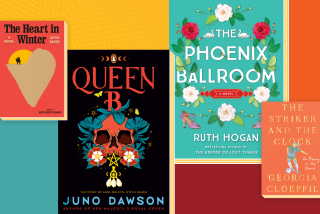Aimee Benderâs âThe Color Masterâ paints worlds of wonder
In Leonora Carringtonâs 1938 short-story masterpiece âThe Debutante,â a young woman wants to disobey her motherâs orders to go to a debutante ball, so she asks a hyena she has befriended to go in her place. The hyena fits into her ball gown but there is then the issue of the hyenaâs face so â spoiler-to-end-all-spoilers alert â they decide the hyena will tear off the maidâs face and use it as her own.
Aimee Bender comes from a similar planet, black-lit brazen and unapologetically wackadoodle, sidesplitting and buck wild. Behold some of the plot lines in her new short-story collection, âThe Color Masterâ: An apple-obsessed gang commits an assault with harrowing Garden-of-Eden undertones. Two sisters go to Malaysia to tend to âunpeelingâ tigers who are bursting out of their stripes. A ârevisionist but backwardsâ German man repeatedly turns himself in for war crimes in Nazi Germany that he never committed. A âcolor masterâ retires and leaves behind a task for his replacement: to make dresses the color of the sun and the moon. A human marries an ogre who accidentally devours their children.
Whether inspired by a painting from fantastical artist Amy Cutler or a 17th century Perrault fairy tale, Bender writes dynamically with the energy of someone just warming up â though this is her third collection of stories. It follows celebrated predecessors âThe Girl in the Flammable Skirtâ (1998) and âWillful Creaturesâ (2005) as well as two novels â âAn Invisible Sign of My Ownâ (2001) and âThe Particular Sadness of Lemon Cakeâ (2010).
But in âThe Color Master,â Bender, like a figure skating champion who has seen gold many times, does not approach the ice trying to top herself. She knows she only needs to hold her record steady, gracefully executing her triple axles, giving her audience exactly what it wants: an Aimee Bender short-story collection.
For why would you need to do something altogether new if you were the one who created a new thing in the first place? Without Bender itâs hard to imagine having young lit-world-indispensables such as Karen Russell or TĂŠa Obreht, for example. Of course Bender herself comes from marvelous roots; sheâs the literary love child youâd be left with if Carrington, Clarice Lispector, Donald Barthelme and George Saunders had a foursome.
Although Bender is more of a conceptual stylist than a syntactical one, the collection showcases moments of trapeze-like linguistic dexterity. Only occasionally does verbal whimsy get tangled in its own goo, resulting in awkward phrases â in âAppleless,â for instance, the ham-fisted descriptor âloaves of hairâ wipes out the lyricism of the descriptions that came before.
But most of the time the writing more than lives up to the ideas. In âRed Ribbons,â she describes her protagonistâs love affair with her own transgressions: âher whole body filled with a sparkling panic, painful and visceral as poison champagne.â In âLemonade,â the teenspeak of her Beverly Center-bound protagonist lets the reader ignore the plot-famished premise and still crave a novelâs worth of the hyper-real voice: âLike sheâs moving her torso but her feet donât move, and then sometimes sheâll take one step and it feels like a thesis statement. Like it is a topic sentence above her butt.â
In âBad Returnâ she similarly nails the droll deadpan of a college student recalling her poet lover: âIt took me until senior year to find a poet who actually wrote poetry, and he took off my clothes very gently and spent nearly an hour on my neck and back, and when we were done and I felt all the waiting had been worth it, he explained that part of his education as a poet was to meet as many women as possible, and so this was now to be goodbye. He suggested I pretend he was going off to war on a boat.â
Which reminds me â while Aimee Bender has been tagged a âmagical realistâ and âpostmodern writer,â she has never been given nearly enough credit as one of our finest humorists. The best parts of âThe Color Masterâ are uproarious; perhaps she has a bit of Lorrie Moore in her blood too? In âWordkeepers,â the neighborâs friend corrects his technology-corroded diction âand when I wrote lol she made a very clear point to me about how I was silent and not laughing out loud, not at all. I said it was just an expression, and that I was laughing out loud inside my own mindâ â and, oh, how we too lol.
Though itâs easy to tag her with the dreaded q-word â quirky â Benderâs work has never been the stuff of manic pixie dream-girl lit. Her fairy tales are dark and wicked, not hipster-precious and faux old-timey. Her sorcery altogether avoids the saccharine, and the thrills and chills of this sometimes sexual, often horror-drenched collection are completely adult.
At a time when realism reigns supreme over the literary landscape, one can argue it is absolutely imperative that Aimee Bender be spotlighted for what she is: a vital MVP of modern letters, period. Fabulism never quite goes out of style, perhaps because itâs never in style in the first place. And what is âstraight realismâ today anyway? In our world of flash-and-trash insta-Internet-oddities and stranger-than-fiction social-media-bloopers, she will have surpassed the simple feat of inventiveness to own a most dazzlingly urgent relevancy.
Khakpour is the author of âSons and Other Flammable Objectsâ and the forthcoming novel âThe Last Illusion.â
The Color Master
Stories
Aimee Bender
Doubleday: 240 pp., $25.95
More to Read
Sign up for our Book Club newsletter
Get the latest news, events and more from the Los Angeles Times Book Club, and help us get L.A. reading and talking.
You may occasionally receive promotional content from the Los Angeles Times.






